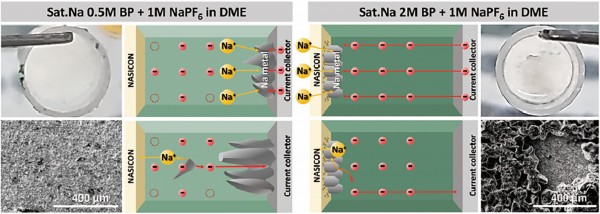Unravelling the impact of electroconductivity on metal plating position in redox-active electrolytes
- Journal
- Energy Storage Materials
- Year
- 2024
Seawater batteries (SWBs), which utilize sodium ions instead of lithium ions, hold significant promise due to the abundance and cost-effectiveness of raw materials. Additionally, SWBs can achieve high theoretical capacities with Na metal anode, and the introduction of redox-active electrolytes enhances the reversibility during Na metal plating and stripping. However, under certain conditions, such as high current density and extended distance between the solid electrolyte and current collector, the redox-active electrolyte can result in inferior cycling performance due to issues with Na metal plating on the solid electrolyte surface. In this study, we investigated the mechanism of Na metal deposition on solid electrolyte surfaces using redox-active electrolytes owning electronic conductivity. Through electrochemical analyses, we elucidated the factors that influence Na metal plating: electronic conductivity, distance, and current density. By controlling the concentration and electronic conductivity of redox-active electrolytes, we established operational parameters to mitigate solid electrolyte cracking and ensure stable cycling, even under conditions of long distance and high current density. Given that instances of Na metal plating on solid electrolytes in battery systems are rarely reported, our research provides new insights and suggests innovative approaches to understanding the mechanisms of Na metal plating and cracking in solid electrolytes.

